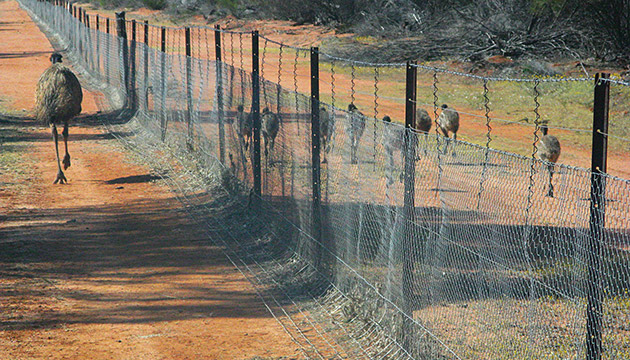Controversy surrounds a proposed 700-kilometre extension to Western Australia's Barrier Fence.
Story By Ken Eastwood
It’s the last section of a line that will cleave Western Australia in two. It’s a 700-kilometre 1.8-metre-high fence that will prevent native animals from moving freely. And it’s a multimillion-dollar barrier to protect West Australian wheat and sheep farms from financial hardship caused by wild dogs and rampant emus.
The 1170km State Barrier Fence was first built in 1901 to keep rabbits out of the productive farmlands of the south-west. It failed. Its primary role more recently has been keeping wild dogs out of sheep-farming areas, and emus out of the wheat. In 1976 its role in doing this came to the public’s attention when an estimated 70,000 emus, desperate for feed in the dry conditions, lined up along the fence and died of starvation or were shot.
Originating at the Zuytdorp Cliffs north of Kalbarri, the existing fence runs south-east along the perimeter of the agricultural region. It has a 165km break – the so-called Yilgarn Gap, which the Department of Agriculture and Food hopes to start closing within six months. The fence then continues to Jerdacuttup in the Ravensthorpe Shire, where it stops. Any dogs, emus or other animals that have reached the end of the fence could just walk around it.
The proposed extension would finish the fence, taking it to the coast at Esperance. If built in relatively straight lines, cutting through remnant woodland and across steep river valleys, it would total an additional 500km. An alignment hasn’t yet been approved, but Western Australia’s Department of Agriculture and Food has favoured an option that would follow the jagged line of cleared farming areas and be around 700km long, costing an estimated $15-20 million.
An alliance of conservation groups, including Birdlife Australia and the Ecological Society of Australia, has labelled the proposed fence extension “an outdated and inhumane approach to managing wildlife,” saying that while the rest of the country is trying to improve and facilitate wildlife corridors, this aims to thwart wildlife movement. They say it will have a disastrous effect on animals large and small and, depending on the eventual placement, could carve existing bushland into less useful small blocks.
This story excerpt is from Issue #89
Outback Magazine: June/July 2013










